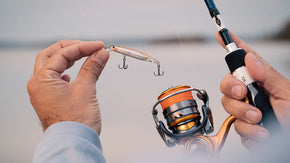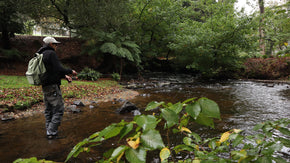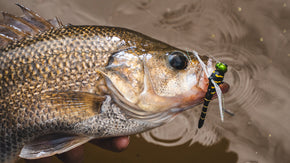Posted 19th November 2025
How to Catch Whiting on Surface Lures


By Joshua Davey
Chasing whiting on topwater lures has a cult like following across much of Australia. Whether fishing the estuaries on the east coast for Sand Whiting, or the shallow intertidal flats on the Southern or Western coasts for Yellowfin Whiting, it’s a form of fishing that captivates many anglers.
Now, I know what you are thinking, another “how to” article, I’m not interested. I understand the basic “how to’s” have been done to death and I want to stray from that a little. Instead, I want to focus on what I like to call the “one percenters”. These are just small little tweaks I have made over the years to my tackle and technique that have seen my catch rates increase, for what can be a particularly frustrating light tackle sports fish.
Before I begin, for context I am based in South Australia, with the majority of my topwater whiting fishing taking place in upper Gulf St Vincent. In saying that, I am sure it is still applicable to many of the waterways across Australia. For this style of fishing, I have been running my Infeet Z 712LFS and been absolutely loving it. Paired with a 2000 size Exceler, spooled with PE 0.6 J-Braid Expedition I get good distance on my cast and the rod provides what is, in my opinion the optimum type of action for working your lure and just as importantly, keeping the hooks in these fish.I did previously mention that I wanted the meat of this article to be based around the subtle changes I have made over the years, so to begin let’s talk about leader.
Alterations to my leader has been responsible for the biggest changes to my catch rates. What do I mean by this? Well I am running 20 – 30lb monofilament (yes I know what you are thinking, stick with me here), specifically J-Thread Nylon. Why on earth would you do that, I hear you all asking? Well, firstly monofilament floats, but you already knew that. Secondly, and most importantly, the heavier leader is significantly stiffer than say a 6lb equivalent. But why is that important?
The key lies in the length of this heavier leader, typically I will only run a length of 15 – 20cm as this provides a few advantages:
* Advantage #1, the leader knot will not go inside of your guides, greatly increasing your casting distance and reducing chances of tangles/wind knots.
* Advantage #2, the supple braid meeting the stiff leader provides a “swivel point” which massively exaggerates the swimming action of your Daiwa Slippery Dog, something the fish can’t seem to get enough of.

As you probably guessed by now, the Slippery Dog is my go to lure for chasing these topwater whiting but we will touch on that more later. I attach my lure using a tight uni knot, typically towards the top of the tow point. Paired with the aforementioned leader combination, this allows me to work the lure at a faster, more consistent pace than a traditional setup. Particularly in wind.
The next little trick is to carry a small hook sharpener, these can be purchased from most tackle stores. Even though Slippery Dogs are equipped with razor sharp BKK assists out of the box, I like to give them a light touch up between fish or after each session. Whiting have a really bony mouth, and I want to give my hooks the best chance possible of finding their mark. Driving those hooks home on fish like whiting can make your hooks go ever so slightly blunt quite quickly and if you have done enough topwater whiting fishing, you know how good they are at just tailing behind the lure nipping at those assists, making razor sharp hooks essential.
Speaking of hooks, I have recently started removing the front treble on my Slippery Dogs. Unfortunately the areas I fish can be absolutely inundated with floating weed and debris. Removing the front treble, leaving just the rear trailing assists can make a considerable difference with getting fouled up with an almost negligible impact on hook-up rate.
Finally, lure choice. These days I find myself more often than not starting my day with the larger 80mm Slippery Dog. It casts further, has a larger presence and seems to draw more attention from any whiting nearby. Don’t let its larger profile fool you, whiting can be seriously aggressive predators. At the very least, if the fish are being a little touchy on the day just use the 80f Slippery Dog as a searching tool, the fish will come up and follow/investigate. If after a few casts you fail to raise a strike, that is when I would downsize to the 65F Slippery Dog.
I hope that you found at least one of these tips useful, or at least piqued your curiosity, Best of luck next time on the water and I hope that these little tricks can help you put a few extra “gold bars” in the bag!
Tight Lines.
















